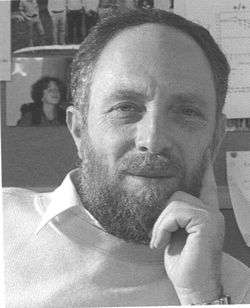David Wallach

David Wallach (born January 23, 1946) is a full professor at the Department of Biological Chemistry at The Weizmann Institute of Science, Israel, and laureate of the 2014 Emet Prize for Life Sciences.[1]
Biography
David Wallach was born in Kiryat Bialik, Israel, where he lived until the age of 18, before moving to Jerusalem. His parents, Tzvi Wallach and Ziva (née Ludmer), emigrated to Israel from Bukovina and Galicia (Eastern Europe)) shortly before World War II. David has a brother and a sister. His sister, Sarah Stroumsa, is a full professor of Jewish Thought at the Hebrew University of Jerusalem, and formerly the university’s rector.
David Wallach’s academic studies, from B.Sc. to Ph.D., were conducted in the Department of Biological Chemistry at the Hebrew University. He did his master’s studies under the supervision of Professor Itzhak Ohad and his doctoral studies under the supervision of Professor Michael Schramm. In these studies, he explored the mechanisms of cell-membrane generation, and of protein packing in glandular secretory granules. His postdoctoral research was carried out on signaling mechanisms at the National Institutes of Health at Bethesda, Maryland under the supervision of Professor Ira Pastan. In 1977, Wallach returned to Israel and joined the Weizmann Institute of Science in Rehovot. He became an associate professor in 1983 and a full professor in 1995.[2]
In 2011/2012, he served as president of the International Cytokine Society.
Wallach currently serves as chairman of the Jewish Galicia and Bukovina organization.[3]
He is married to Naomi (née Rosenberg), a writer and painter, and they have two children, including the poet Rachel Wallach.
Awards
- 1997 – Teva Founders Prize in the field of Cell Signal Transduction[4]
- 2012 – Merck Serono Prize
- 2012 – Rappaport Prize in Biomedical Sciences in the Established Investigator category[5]
- 2014 – Emet Prize, Life Sciences category in the field of Biotechnology
Studies
Since 1977, Wallach has been studying the functions of cytokines and their signaling mechanisms, focusing on a cytokine group known as the ‘TNF (Tumor Necrosis Factor) family’, as well as on cell-death mechanisms. Wallach’s lab was of the first to demonstrate that TNF can affect a variety of cellular activities including some that contradict each other, such as the induction of cell death and the induction of resistance to cell death.[6][7]
Wallach was among the first to isolate TNF[7] and its receptors.[8] He deciphered the extrinsic cell-death pathway, as well as some of the mechanisms of activation of transcription factors of the NF-κB family. Among the molecules first cloned at his lab are the protease caspase-8,[9] the adaptor protein FADD (MORT1), the cell-death inhibitory protein cFlip, the protein kinase NIK,[10] and the adaptor protein NEMO (IKK-γ). Wallach’s work has contributed to the discovery of the ‘death domain’ protein motif, and provided the first evidence that proteases can serve as intracellular signaling molecules.[11][12]
These discoveries aided the development of TNF-inhibiting medications, including Etanercept (Enbrel) and adalimumab (Humira) that are widely used to treat chronic inflammatory diseases such as rheumatoid arthritis, psoriasis, and the inflammatory bowel diseases Crohn’s disease and ulcerative colitis.[2]
References
- ↑ C.V. of Prof. David Wallach, Emet Prize Laureates, Emet Prize site
- 1 2 David Wallach at the Emet Prizes website
- ↑ Board, Jewish Galicia and Bukovina organization site
- ↑ (22 March 1998) 1997 Teva Founders Prize To Weizmann Institute's Prof. David Wallach, The Weizmann Institute site
- ↑ (March 5, 2012) Rappaport Prize in Biomedical Sciences. Hayadan site
- ↑ Wallach, D. (1984): Preparations of lymphotoxin induce resistance to their own cytotoxic effect. J. Immunol. 132, 2464-2469. PMID 6609199
- 1 2 Hahn, T., Toker, L., Budilovsky, S., Aderka, D., Eshhar, Z. and Wallach, D. (1985): Use of monoclonal antibodies to a human cytotoxin for its isolation and for examining the self-induction of resistance to this protein. Proc. Natl. Acad. Sci. USA 82, 3814-3818. PMID 3889916
- ↑ Engelmann, H., Novick, D. and Wallach, D. (1990): Two tumor necrosis factor binding proteins purified from human urine. Evidence for immunological cross reactivity with cell surface tumor-necrosis-factor receptors. J. Biol. Chem. 265, 1531-1536. PMID 2153136
- ↑ Boldin, M. P., Goncharov, T. M., Goltsev, Y. V. and Wallach, D. (1996) Involvement of MACH, a novel MORT1/FADD-interacting protease, in Fas/APO1- and TNF receptor-induced cell death. Cell, 85, 803- 815. PMID 8681376
- ↑ Malinin, N. L., Boldin, M. P., Kovalenko, A. V. and Wallach, D. (1997) MAP3K-related kinase involved in NF-kB induction by TNF, CD95 and IL-1. Nature, 385, 540-544. PMID 9020361
- ↑ Wallach, D., Varfolomeev, E. E., Malinin, N. L., Goltsev, Y. V., Kovalenko A. V. and Boldin, M. P (1999) TNF receptor and Fas signaling mechanisms. Annu Rev Immunol. 17, 331-367. PMID 10358762
- ↑ Wallach, D. (2013) The TNF cytokine family: one track in a road paved by many. Cytokine 63: 225-229. PMID 23792010
External links
- Prof David Wallach – The TNF Group (official website at The Weizmann Institute of Science)
- David Wallach at the Emet Prizes website
- David Wallach at the Rappaport Prizes website
- David Wallach short cv at the Rambam Health Care Campus